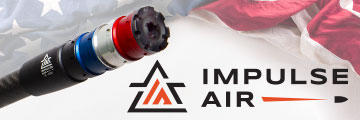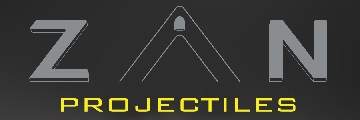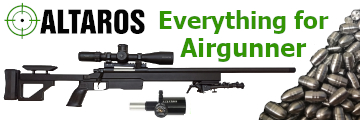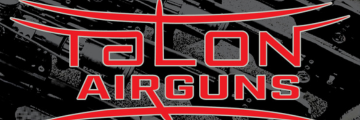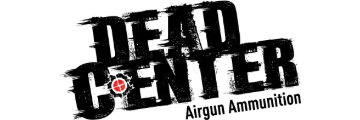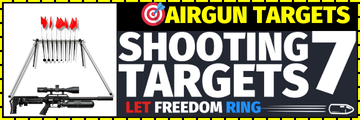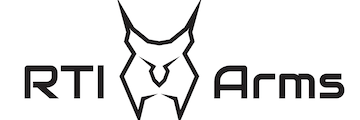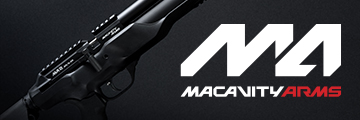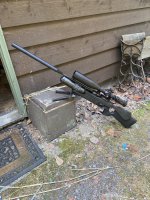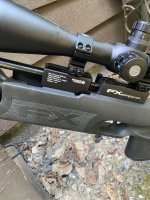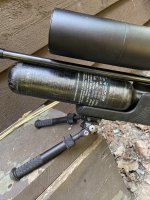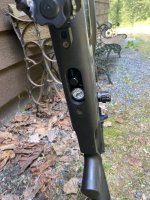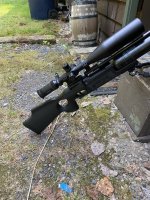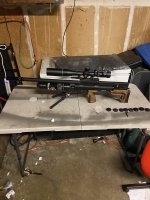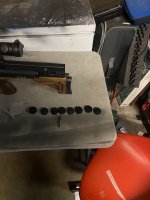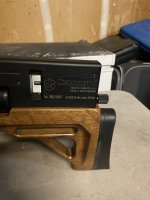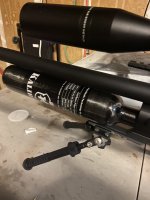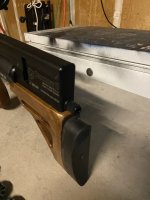Ok ,after a few requests on how I dye and Finnish beech stocks. I will offer how I do it.. NOTE. ITS NOT THE ONLY WAY OR THE BEST BUT RATHER A SIMPLE WAY TO GET UNIFORM RESULTS with available products from local stores.
Factory beech stocks are done in a spray booth with spray dye and tinted Finnish sometimes. Using a two part conversion varnish.
Could we duplicate the process. YES ! If you have the booth and know how to spray two part conversion finish.
Newer stocks may use two part waterborne but they still dye them.
First let’s look at the wood species. Beech ,it’s a very tight grained wood , mainly European and German origins. We have beech here in the states but it’s not ne’er as prevalent. It’s very dense and shock resistant. Many old machine shops used it under big machinery.
Like our oaks and Walnuts ,Beech is a big percentage of their cheaper easier to get lumber. As it is, it’s not always the prety color and grain of Walnut . It works well for Airgun stocks that have a lot of shock. Springers especially.
Beech tends to be a white to cream colored with tiny specks ranging from flame to swell grain. In Quartered forum it’s got great fleck or medullary rays.
All that being said it’s not so oh easy to finish uniformly with wipe on oil penetrating stains and the such.
It finishes a nice blond uniform color in natural state with darker to lighter flecks that will create chatoyance. Those same flecks and rays drive finishers crazy trying to stain them as their density does not take color well. Hence the dying and pre dyed sealers to try and blend the color to uniformity.
Ok. Enough of the professor garble.. let’s get to it.

First thing is get a empty swear jar , and a case of

. Or whatever imbibing vice, you will need both.

The number one goal is to get the beech stock as clean and remove all of the existing old finish.
That can be done with Stripper and thick rubber gloves. With a purple Scotch Brite pad. The strongest stripper you can get. ( don’t go down to the local adult bar and ask for NELL , although ,you may need her for moral support). Methelene chloride kind. I’ve had some not budge, old Webley and HW stocks. Newer guns are far easier as the new finish isn’t as durable as yesterday years of Voc lung buster finishes.
Second crack a adult beverage prior to stating as nothing taste better than a stripper on your bottle.

FOR YOU GUYS WHO START SANDING THE COMPLETE STOCK TO GET TO BARE WOOD. ILL BUY THE

AND WATCH. YOUR AN ANIMAL AND BELONG ON THE UFC
MATERIALS NEEDED.
Chemical stripper.
SAND PAPER. 120/220/320
Oxyclean
denatured alcohol
Trans Tint dye
Scotch Bright
Hair dryer. Optional.
Oil based spray polyurethane … I use Minwax in black can , Warm Satin sheen give a great look with a semi sheen but duller
Fan box type.
rubber goves
eye protection
respirator for those SAFTY types.

.
terry towels
vinegar
steel wool
jar
jar for solution
BEER
PATIENCE
DAY 1
THICK KITCHEN RUBBER GLOVES MANDITORY.
This is a long process, small areas. Wet, let sit , and scrub till bare COLORED wood shows. Take a TOOTH HOLDING PULL OFF YOUR

, repeat for the time it takes. During this time ,remember that empty jar. Put a buck in it every time you swear you will never do this again. By the time your done you could use it to buy a new stock.

Dont try to get every BIT of color yet. It’s just the film coating we NEED OFF. We have future tools for that. Once you get the stock stripped of all film and dull ,usually lighter brown. open a new

. As your lips are numb by now from the old stripper bottle combo.. If you can taste the new one you were lucky and the lord blessed you and finish didn’t fight ya.. Add a buck to jar for your efforts and the pain and mind swearing you did.
Wait a few hrs for stripper to really dry and swelling to go down. It’s a great time to sit back and enjoy those

If your in a hurry a hair dryer is your friend. Remember wet moist wood don’t sand well.
Once it’s to bare wood there is the color removal. First we are gonna stare into a mirror and recite. “ I’m good enough, I’m smart enough,and dogone , people like me” SS . YOU will feel better for it.
Depending on how deep the color is ,you need to get as much off as you can. Especially if your attempting to go lighter. That’s a whole step I’ll mention later. Usually most will want to go factory look or darker or even pastel as it’s now in vogue.
Start sanding with 120 with the grain. Removing color till blond wood is revealed. Take a sip now. You just earned a blond point.
Continue sanding with 120 till 90% or more of color is gone.
Ok, relax. You are now NO WHERE CLOSE TO EVEN BEING DONE. Open

,insert

into jar.
Repeat same process with 220 concentrating on unevennspots or dark spots. Insert

into jar as they are still gonna be there.
Now , before you go farther, call your priest or rabbi and ask them to pray for you as your arms to weak to raise up Your

let alone pray..
Day 2 or those who live in ARIZONA still day one if your sober.
If your one of the lucky ones that your stock finish just melted like hot knife in butter , WE HATE YOU ..(just kidding, congrats) USUALLY , I DO THIS IN A FEW DAYS AS THERE ISN'T ENOUGH ROOM IN THE JAR , AND I RUN OUT OF

… CRYING MAMA.

In all seriousness it’s because I don’t want to add more moisture to the wood. The stripper does add some and THIS STEP WILL TO.
SO if your at 220 with darker areas still it’s time for Chemical warfare. EYE PROTECTION IS A MUST.
mix a solution of Oxalic acid / oxyclean and water .. Wipe the stock down sat ( For stubborn stocks ,I’ve used pool breech,shock)
let sit until it drys. Sunlight helps. If you see powder forming just drink a

and shut your garage door.

Its the acid bleach working to raise color. You can scrub the areas with Scotch bright and bleach to get deeper
By now the stock should be 98% stain free. Grain streaks or SPALT line will NEVER bleach out or sand out. Remember uniformity is the goal. It’s mother natures work and she does beautiful work. Raise toast to her now

.
Repeat sanding of complete stock with 320. This is where the last bit of achievable color will come out. I said achievable because some may never come all out.

put a

in the jar.
It’s ok ,don’t fret unless your trying to go natural. Then you may have to revert to the (shock treatment). Those light ingrained spots will usually blend with the dye. It is IMPERITIVE THAT YOU GET ALL SCRATCHES OUT NOW FROM PREVIOUS SANDING. if 320 won’t drop back to 220 in that area and back up to 320. To blend. Completely scratch free is what you need as if it’s left there dye amplifies and and finish will reward it for doing so all the wile staring you in the face mocking your poor efforts.

By now your reciting Ricky Bobby’s ,I pray to Jesus, manta.. throwing

at the jar in hate.
Day 3. YOU MADE IT. Probably a little fuzzy from the wife scalding you took for rolling in like Orry Lee Kennedy.

we can blame the bleach .
OK your now into the scientific part. Mixing and making potions , You know Harry Potter and the likes. Wizardry

No beer

yet..
[[[[[[[********* For black Ebony Stocks or rich dark chocolate brown this step is needed. This is called Iron Acetate wipe down and what it does is make the wood darker And more uniform. So dye is not so transparent.
IS IT NEEDED FOR MOST LIGHT TO MEDIUM BROWNS .. USUALLY NOT but, BLACK IS MANDATORY OR DARK INTENSE COLORS
IRON ACETATE …. SOUNDS SCIENTIFIC. .. ITS NOT.
Mix up a quart jar of 2 cups of white vinegar and half wad of cleaned with denatured alcohol steel wool a few days prior to planing the color coat.
Let it sit for at least 24 or more ,it gets more intense the longer it sits. I always make mine at least 3 days prior. MAKE SURE TO POKE HOLES IN THE LID OR USE A TOWEL TO COVER AS THE ACID WILL OFF GASS AND NEEDS TO FOR THE FORMULATE WORK. ITS NOT CAUSTIC TO YOU SO DONT WORRY. LEAVE IT IN THE GARAGE OR SHED. OR BASEMENT. ……… or your wife’s night stand as sweet tea.

. (Just kidding)
With a clean stock completely wipe down the wood with a uniform wet rag , don’t be stingy wet it down. It will and should start turning anywhere from dark brown to grey and will darken more and even out after drying.
This needs to dry for at least a day in natural weather or half day in Nevada
A hair dryer is not good as you want the acids to do their thing.
After dry time you will see darker uniform stock that is either grayish to brownish. Every wood is different. It’s not a color process as much as a blending for dark colors. ]]]]
Completely wipe all dust or blow off with compressed air.
set on clean towels.
DEPENDING on The COLOR.. Your going to have to experiment a tad, if you have never worked with dye. Make samples.. White pine gives a idea of how intense and close for samples. You can always lighten it if it’s to dark later ,but rarely as it’s pretty east to mix desired color.
Start with 1 cup of denatured alcohol to 10 good drops of trans tint. ( don’t be cheap ,it’s not cheap but you want color soak ) Mix up. You can always add more dye to depending color you can’t add alcohol to get more product so mix enough and then some .. ITS BETTER TO HAVE ENOUGH THAN TO WISH YOU WERE NOT SO FRUGGLE AS A RUN OUT MID JOB ..
If making samples ,record your mixing ratios.. don’t be afraid to add more ,it only intensifies the color
Now open a

, celebrate your Enrico Fermi ability ,before the color coat as you can’t when dying it’s messy and you will look awfully funny from it.
Put your gloves on and get a small towel waded into a ball. About the size of a golf ball, and very wet . Apply the dy with a firm press to buff out and smooth off wood . It will dry very fast from the Evaporating alcohol but keep smothering it .. Once it’s it’s all colored you will re apply a second and third time with light feathering off method to get it deep into the wood as possible. By now your reaching for

beers as it looks disastrous to the uneducated.
RELAX.. it’s not GONA get rich and intense until finish is applied. It should be dry dull with uninamanimaty.

UNINAMANIMITY, is what we are looking for. Touch up areas with small towel or brush.
DO NOT WIPE THE DYE OFF ITS NOT STAIN. Blend it and let it dry. In 2 mins it’s surface dry not chemically though.
Once your satisfied with the color LET DRY FOR 24 hrs It’s very important that all the pigments dry deep into the wood.
Rush it and coat to early and your reward is A re strip re dye .. 24 hrs min.
DAY 4 Depending on if you used iron acetate or not maybe 5
I look the stock over well for any obvious signs of issues. Grain showing through or speck flake grain that just won’t take. I deal with those with colored Sharpies and a fat thumb or touch up left over Dye. I never use any oil stain in the process.
Why ..many here have and will say that’s BS , RELAX Frances. There are many ways to skin a cat ,this is just what consistantley has worked for me.
If repairs are made use hair dryer to speed dry.
I set up a box fan on low behind me a ways back, with a dowel or Some method to hold it into the trigger guard area but IT HAS TO BE SECURE
Some will Suspend it and walk around it. I like my fan directionally blowing any over spry away. It’s on low 10 feet back
BY now you haven’t put

in the jar from your proud ego.. THROW 5

in there because you want to please any god as you will benefit from all the luck you can
I hold the stock in my left hand full arms length away using Minwax oil poly , water Based can wash out the dye revealing the beautiful beech your trying to hide hidden underneath.

Spray the first coat very light at a fast rate. The stock will drink this up fast , move along keeping the can past the ends overlapping
Let that seal coat sit for at least a hr. open

and weep drinking at either your success or failure as you drink and stare at it.
If your sober still ,,,you succeeded at creating a uniform as can be beech stock
Its all down hill from hear as the dye now has been locked under the sealer and will not move as polyurethane isn’t a reactive finish but rather a film building type.
Repeat the second coat as the first ,………….or if it’s disaster continue on the


. It’s only a strip and re dye…I’ll explain that in a bit for you failures

Let each coat dry for a hr.. as your putting your third coat on you should start to see it wet off and shine like a glass
LET DRY , REFUSE TO SAND YET. SANDING BETWEEN COATS IS A PROCESS WHEN FURNITURE IS SPRAYED NATURAL And has ample sealer
The Minwax oil poly is very forgiving. I’m sure other brands are out there that may work better or as good Feel free to experiment. This has worked for me and I hate re doing stuff when I could be relaxing shooting them or

By now the stock should have 4 coats on it. With a even satin film if there is good build and no grain raise spray another coat on to get the build up. Once you have the build you want , (I usually go till no its glass smooth), and are happy you can either leave it or let it dry for a week and see if finish falls into the wood and needs more. At this time you will need a super fine sand with 400 tp 600 to re apply , but doing one every hr will not as it’s a hot coat bond.
If its slightly orange peeled wet sand with 400 to 600 but be gentle , edge sanding and blow through will send you to the

jar fast
I usually end up with around 8 to ten coats or this. Remember it’s not brush on finish with a much higher solids content so build is incremental
Restrip is done with a lot of

and lacquer thinner scrubbing a scotch brite. Then clean up with sand paper as stated. And re dye and Re try.
I’m sure I missed a lot as it’s old hat for me but I hope this helps. I’m off to have a

. With the money from the jar.

























